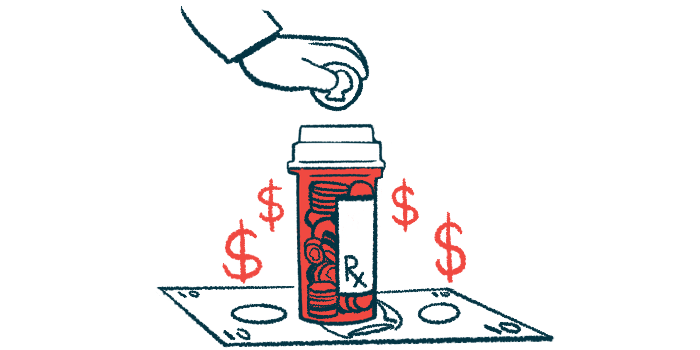Kesimpta More Effective, Costs Less Than Most DMTs for RRMS: Analysis
Canadian analysis finds possible lifetime savings up to CA$41K

Kesimpta (ofatumumab) is more cost-effective for treating relapsing-remitting multiple sclerosis (RRMS) than most other disease-modifying therapies (DMTs) approved in Canada, according to a new analysis.
The analysis indicated that Kesimpta is generally more effective and associated with fewer costs than the majority of MS treatments, with the exception of glatiramer acetate. However, while glatiramer acetate — sold as Copaxone, with generics also available — did have fewer costs, it was less effective.
“This analysis is the first to show that [Kesimpta] is cost effective, and often dominant (more effective, lower costs), compared with currently approved and reimbursed DMTs for RRMS by the Canadian public healthcare system,” the researchers wrote.
Indeed, using Kesimpta as a first-line treatment could result in lifetime savings of up to CA$41,000 (about $30,000), the data showed.
“Taken together, these findings may help guide treatment decision making for clinicians and their patients,” the investigators wrote.
The study, “Cost-Effectiveness Analysis of Ofatumumab for the Treatment of Relapsing-Remitting Multiple Sclerosis in Canada,” was published in PharmacoEconomics. The work was supported by Novartis Pharmaceutical Canada. Novartis markets Kesimpta.
Investigating DMT cost, benefits
Due to its chronic and sometimes progressive course, MS poses a significant economic burden for patients and the healthcare system. In addition to using a significant amount of healthcare resources, patients often lose the independence needed to perform daily activities, leading to unemployment that exacerbates the financial burden of MS.
Appropriate and early disease management is critical for reducing this burden and improving outcomes for people with MS. However, there are, to date, 16 approved DMTs in Canada, all with varying degrees of efficacy, as well as different safety profiles.
These factors influence the true cost-effectiveness of these treatments in clinical practice.
“Given the increasing number of available DMTs, alongside the substantial economic burden associated with MS, it is critical to identify which treatment options are cost-effective,” the researchers wrote.
CD20 medications that selectively eliminate B-cells have a high degree of efficacy in MS, but tend to be more burdensome to patients and the healthcare system because they are injected into the bloodstream, requiring a greater use of time and resources.
Kesimpta is a CD20 inhibitor that can be self-administered at home, via a subcutaneous, or under-the-skin, injection. The medication, approved last year in Canada, has been ranked among the most efficacious DMTs in MS and also has a favorable safety profile. Thus, it could offer a cost-effective and convenient treatment option for RRMS patients, according to its developer.
To learn more, researchers in Canada now evaluated the cost-effectiveness of Kesimpta against other DMTs for RRMS patients with active disease.
A model was developed to predict the likelihood of a treatment being cost-effective. A number of information sources were used to build this prediction model, including data from clinical trials, the British Columbia database, other Canadian data sources, and available literature.
Information under consideration in the model included side effects, efficacy, treatment discontinuations or switches, and cost.
Ultimately, incremental cost-effectiveness ratios were generated, which reflected the economic value of Kesimpta against a comparator medication. This value takes into account the quality-adjusted life years (QALY) — a measure of how much a treatment lengthens life, adjusted for the quality of life in the extra years lived.
Kesimpta most cost-effective
The results showed Kesimpta is dominant — that is, associated with greater effectiveness (more QALYs) and lower costs — over other medications indicated for first-line treatment of RRMS. These included Aubagio (teriflunomide), interferon-based therapies, Tecfidera (dimethyl fumarate), and Ocrevus (ocrelizumab).
In a prediction of cost savings over a lifetime, the team estimated using first-line Kesimpta could save between CA$12,022 (about $8,700) and CA$41,817 (about $30,500), depending on the comparator treatment.
The only notable exceptions were glatiramer acetate and best supportive care, which were less effective than Kesimpta, but also associated with fewer costs.
The researchers estimated that, compared with glatiramer acetate, Kesimpta was associated with an increased cost of CA$24,189 (about $17,600) per each QALY gained.
This increased cost fell below the established threshold of CA$50,000 (about $36,400), meaning the Canadian healthcare system would be willing to pay more for Kesimpta to benefit from its greater efficacy.
Based on their analysis, the team determined Kesimpta had the highest probability of being cost-effective, with a 64.3% likelihood.
“The cost effectiveness of ofatumumab is driven not only by the high treatment efficacy … but also by the reduction in total costs against all comparators except glatiramer acetate and [best supportive care],” the researchers wrote.
In another analysis, the team also found that Kesimpta was more cost-effective than second-line therapies, such as Tysabri (natalizumab) and Gilenya (fingolimod). However, Kesimpta was associated with an increased cost of CA$50,969 (about $36,400) per QALY when compared with Mavenclad (cladribine).
“Together, these results suggest that early initiation of treatment with [Kesimpta] benefits both the patient (i.e., greater QALYs gained) and the healthcare system (i.e., lower total costs),” the researchers wrote. “Given [Kesimpta’s] high efficacy, favorable risk–benefit profile, easy and accessible route of administration, and demonstrated cost effectiveness, it should be considered a valuable early treatment option for patients with RRMS.”








